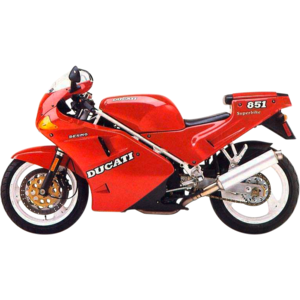Ducati 851 [1991-1994]: A Timeless Superbike Experience
Introduction
When Ducati unleashed the 851 between 1991 and 1994, it didn’t just release a motorcycle—it redefined what a production superbike could be. Born from homologation requirements for World Superbike racing, the 851 blended track-derived engineering with street-legal practicality. Even decades later, this machine remains a benchmark for V-twin performance and emotional design. Let’s dissect why the 851 still commands respect among riders who crave mechanical character fused with razor-sharp dynamics.
Design & First Impressions
The Ducati 851 looks like it’s moving even when parked. Its angular fairing, trellis frame, and signature single-sided swingarm (on later SP models) scream late-’80s Italian audacity. The riding position is committed but not torturous—a compromise between race tuck and street usability. The seat height feels accessible at 790 mm (31.1 inches), though the narrow tank helps shorter riders plant their feet.
The 851’s design language—aggressive yet elegant—still turns heads today.
Build quality is typical of ’90s Ducati: functional but not flawless. Fasteners show a mix of steel and aluminum, and the iconic red paintwork chips easily. Yet, these quirks add to its charm. The 42 mm USD Showa forks (430 ml oil capacity per leg) and Brembo brakes hint at its racing pedigree, while the 17-inch wheels shod with 120/70 front and 180/55 rear tires keep it grounded in modern rubber standards.
Engine & Performance
At its heart lies an 851 cc (later 888 cc in SP models) liquid-cooled 90-degree V-twin with Desmodromic valve actuation—a Ducati signature. This engine isn’t just a powerplant; it’s a mechanical orchestra.
Key Figures:
- Power: Ranges from 93 HP (67.9 kW) @ 9,600 RPM (Strada) to 100 HP (73 kW) @ 8,000 RPM (SP3)
- Torque: ~85 Nm (63 lb-ft) at mid-rev range
- Top Speed: 225–245 km/h (140–152 mph) depending on model
Thumb the starter, and the engine barks to life with a guttural thump-thump idle. The Desmo valvetrain clatters faintly—a reassuring reminder of its precision. On the move, power delivery is linear but urgent. Unlike inline-four rivals, the 851 doesn’t scream; it builds. By 6,000 RPM, the V-twin shoves you forward with a surge that peaks near redline at 10,500 RPM.
The 6-speed gearbox (15/37 sprockets, 98-link chain) requires deliberate shifts—a trait softened by aftermarket slipper clutch kits. Fueling can feel abrupt at low RPMs, but this is a bike that rewards aggressive throttle use.
Handling & Dynamics
Weighing between 210–224 kg (463–494 lbs) wet, the 851 feels surprisingly nimble. The steel trellis frame and Showa suspension (adjustable preload/rebound) strike a balance between track stiffness and street compliance.
At speed: The front end stays planted, even under hard braking into corners. The 120/70-17 front tire offers sharp turn-in, while the 180/55-17 rear provides stability mid-corner.
At low speeds: The steering feels slightly heavy, but the bike remains manageable. The 1,440 mm (56.7-inch) wheelbase ensures stability without sacrificing agility.
Braking is a highlight. Dual 320 mm Brembo discs up front (with four-piston calipers) deliver progressive bite, while the rear single disc does just enough. Swap the original pads for modern sintered compounds, and stoppies become a real possibility.
Competition
The 851’s era pitted it against Japan’s inline-four giants and Europe’s rising stars. Here’s how it stacked up:
Honda RC30 (VFR750R)
- Pros: Legendary reliability, smoother V4 powerband, bulletproof build.
- Cons: Less raw torque, heavier at 235 kg (518 lbs), sterile character compared to the Ducati.
Yamaha FZR 750R (OW-01)
- Pros: Rev-happy 749 cc inline-four, 120 HP peak, sharper electronics (for the time).
- Cons: Narrower torque curve, less feedback from aluminum frame.
Aprilia RSV Mille (Later Contender)
- Pros: More modern chassis (1998+), 60° V-twin with 118 HP.
- Cons: Arrived late to the party; lacks the 851’s homologation pedigree.
Verdict: The Ducati 851 trades outright horsepower for soul. Its torque-rich V-twin and telepathic chassis make it a rider’s bike, while rivals prioritize usability or peak numbers.
Maintenance
Owning a 851 requires dedication, but MOTOPARTS.store has you covered:
Critical Service Points:
- Valve Adjustments: Every 12,000 km (7,500 miles).
- Intake: 0.10–0.12 mm (0.004–0.005 in) cold
- Exhaust: 0.15–0.17 mm (0.006–0.007 in) cold
-
Pro Tip: Use a Desmo shim kit to simplify adjustments.
-
Oil Changes: 3.3 liters (3.5 quarts) with filter. Use 10W-40 synthetic for optimal protection.
-
Cooling System: Flush every 2 years with ethylene glycol-based coolant (2.9L capacity).
-
Brake Fluid: Replace DOT 4 annually. Upgrade to high-temperature fluid for aggressive riding.
-
Chain Care: 98-link 525 chain. Maintain slack at 25–30 mm (1–1.2 in) and lubricate every 500 km (310 miles).
Common Upgrades:
- Exhaust: Swap the stock cans for a Termignoni full system to unlock 5–7 HP.
- Suspension: Retrofit Öhlins cartridges for sharper damping control.
- Electronics: Install a modern voltage regulator to prevent charging issues.
Keep your 851 running strong with MOTOPARTS.store’s curated maintenance kits.
Conclusion
The Ducati 851 isn’t just a motorcycle—it’s a statement. From its sonorous Desmo V-twin to its race-bred chassis, every ride feels like an event. While newer bikes offer more power and gadgets, none replicate the 851’s analog thrill.
Whether you’re restoring a garage find or optimizing a weekend warrior, MOTOPARTS.store has the parts and expertise to keep your 851 dominating both backroads and coffee shop parking lots. After all, legends deserve immortality.



















